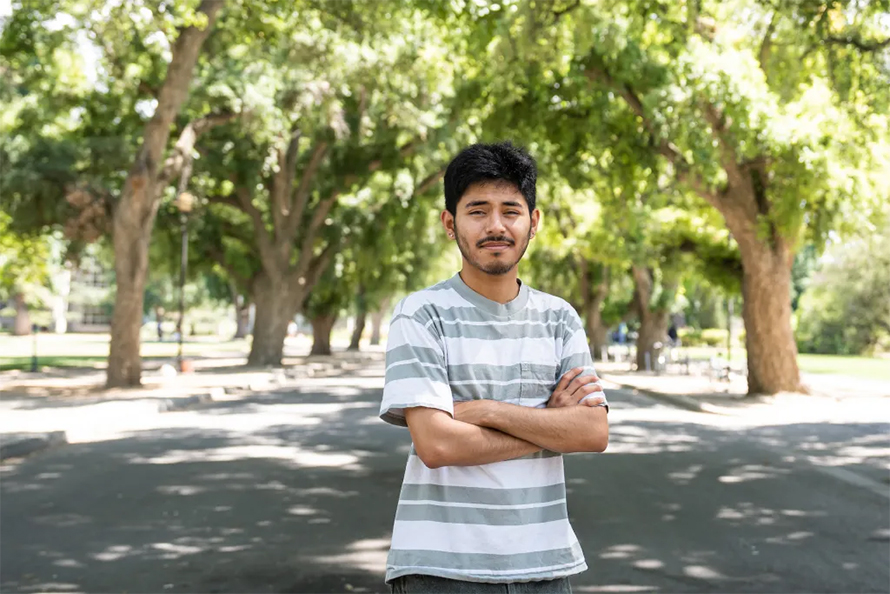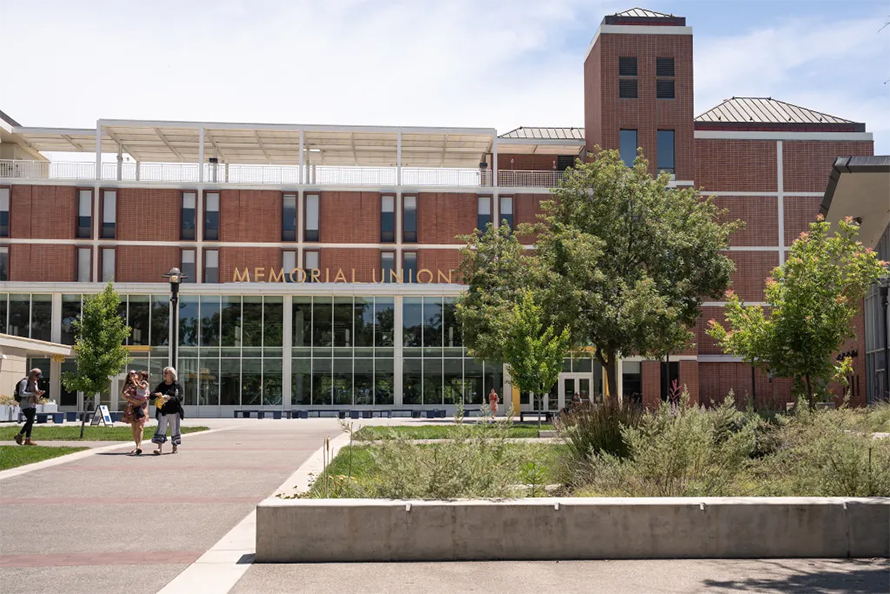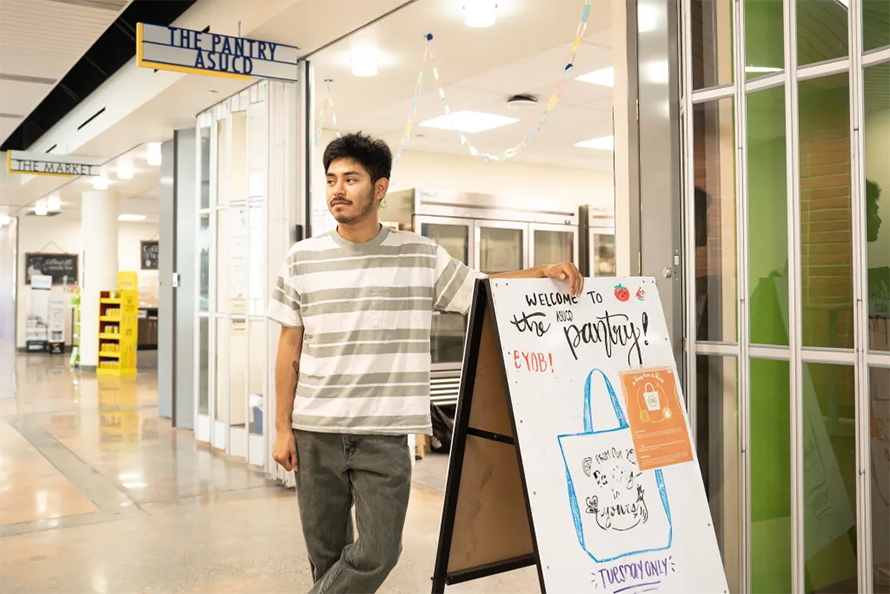Work rules for benefits programs deter low-income Americans from going to college
Sergio Bocardo-Aguilar was hungry. A first-year student at the University of California, Davis, he worked at a fast-casual restaurant, but still couldn’t afford food. After his shifts, he would ask his friends for snacks or leftovers. Some nights he went right to sleep instead of having dinner.
Bocardo-Aguilar wondered if public assistance programs could help him. But he didn’t qualify for the federal Supplemental Nutrition Assistance Program, known as SNAP or food stamps. He worked two fewer hours per week than the program required — 18 instead of 20.
Because it’s hard to put in that much time on top of a full course load, “the work-hour requirement is really annoying, especially for a lot of students, like me,” he said. “I definitely think it should be eliminated, especially for students.”

That work rule was loosened for students during the peak of Covid-19 but has now been reimposed; at least one member of Congress says that nearly a million students are at risk of losing SNAP benefits as a result.
Now, under the deal to avert a default on the national debt, more work rules are being added to SNAP and other benefits programs. Advocates say that these types of restrictions are deterring Americans from going to college and getting higher-wage jobs.
Federal benefits programs are largely designed to exclude college students. Even if they meet SNAP’s income requirements — less than $1,473 per month for a single person — college students don’t qualify for benefits unless they work 20 hours on top of going to classes or meet other conditions such as caring for a dependent child under age 6.
Not only does this leave students hungry, say experts and advocates, it discourages SNAP recipients who are not already in college from enrolling.
This story was produced by The Hechinger Report, a nonprofit, nonpartisan news outlet focused on education.
College graduates with an associate degree earn on average 25 percent more over their lifetimes than people with only a high school diploma, and bachelor’s degree recipients get the kinds of jobs in which they generally make 75 percent more, according to the Georgetown Center on Education and the Workforce. Changing SNAP rules to encourage education, rather than just employment, could help more people improve their circumstances, critics say.
“Higher education is workforce development,” said Carrie Welton, who directs basic needs and anti-poverty policy at The Institute for College Access & Success. “Government programs should be the last entity that should be restricting things that we know work.”
As states try to increase the number of adults with degrees and credentials, advocates say easing work requirements for programs like SNAP, at least where students are involved — rather than the current trend of adding more — could put recipients on a path to prosperity and make them less likely to need government assistance in the future.

“If these individuals are able to get these credentials, these bachelor’s degrees and other vocational credentials, they could get off these public benefits and be able to get to a family-sustaining wage,” said David Croom, associate director for postsecondary success for parents at the Aspen Institute. “We want to incentivize people getting high-quality credentials relatively quickly in an affordable way.”
SNAP isn’t the only program that advocates say discourages education in favor of work.
Take the federal Temporary Assistance for Needy Families program, or TANF: States have leeway over how they implement the program, but a certain percentage of TANF recipients in each state need to be working to meet federal rules. That means coordinators avoid directing too many recipients into education, said Bryce McKibben, senior director of policy and advocacy at the Hope Center for College, Community and Justice at Temple University.
“The federal financial aid system, like Pell Grants and our student loan program and state and institutional aid — those programs are intended to help the most low-income folks in our country make their dreams possible,” McKibben said. But eligibility restrictions “make it so that those folks would have very severe consequences for themselves or their families if they wanted to enroll in higher education.”
The focus on getting program recipients employed comes largely from a desire to make them self-sufficient and no longer in need of aid. But experts say that a degree or credential could help achieve that while generating other economic benefits for states.
Parker Gilkesson previously worked with people in North Carolina to determine their eligibility for programs such as TANF. In some of the state’s counties, leaving a job or reducing hours to attend college is specifically singled out as a reason TANF recipients could lose their benefits.
In her experience, the policy “would just force people to push education to the side and go on and get a lower-wage job and perpetuate a cycle,” said Gilkesson, now a senior policy analyst at the Center for Law and Social Policy.

For current students, the work requirements can make it more difficult to do well in school and graduate. Students who work while in college are 20 percent less likely to finish their degrees than classmates who don’t, according to new research.
“It does take away from their academic studies,” said Brandi Simonaro, who co-directs SNAP outreach for public colleges as a project director at the Center for Healthy Communities at California State University’s Chico campus.
When she was a student, Simonaro was on CalFresh, the state’s SNAP program. Working more than 20 hours, as required to continue getting benefits, “really affected my ability to be present on campus,” she said. “Going to office hours was a struggle.”
Aaron Kunst, another co-director of the outreach program, said he worked with a student who was both homeless and employed, but still failed to meet eligibility requirements for CalFresh.
Outreach coordinators like Simonaro and Kunst can help students navigate the sometimes-dizzying experience of applying for federal benefits. Often, students think they are ineligible, even if they’re not, as government websites paint a discouraging picture. Without help, the complexity of the requirements and the number of hoops students must jump through, including an interview, can become barriers to access.
“Most people are just going to see the list of rules and be like, ‘Forget it. I just don’t have time to deal with that bureaucracy,’ ” said McKibben. As a result, they choose not to attend college or apply for benefits.
Ivan Roberts, a student at Bowie State University in Maryland, said he believes he has been eligible for SNAP, but doesn’t know where to turn for help in applying. He has applied for SNAP three times but has never heard back. Without support, he has had to choose between paying to resolve holds on his student tuition account or buying food. That has gotten in the way of his academic progress, he said.
“If I had the money to take care of school and the money to sustain myself just to meet my individual needs, a lot of the problems I did have with school would have never arose,” Roberts said.
During the peak of the pandemic, students were able to receive assistance if they were approved for work study or if their parents were not expected to contribute financially to their educations. But with the public health emergency declared over, those exceptions ended on June 10.
And although the debt ceiling deal between the Biden administration and congressional Republicans will expand access to SNAP for young adults who age out of foster care, it will also raise from 50 to 54 the age at which older adults receiving SNAP are required to work and make it harder for states to exempt families of any age receiving TANF from the work requirement.
Politicians typically don’t want to be seen extending benefits to students who appear poor but are being supported by their families, advocates say. Benefits programs are also some of the most costly federal initiatives.
“The student rules were put in in the ’70s over concerns that upper- and middle-income kids, who looked temporarily poor because they were in college but were actually being financially supported by their parents, would be able to access SNAP,” said Welton. “Some of those concerns are I feel like not only a red herring but also fairly unfounded in terms of what the data tell us.”
More than half of all college students are considered independent, according to an analysis by the Institute for Women’s Policy Research. Nearly 30 percent of those at four-year colleges experienced food insecurity during the pandemic, the Hope Center reports.
“Today’s students are not the traditional students of years past,” said Satra Taylor, who directs higher education and workforce policy and advocacy at Young Invincibles, an organization focused on young people. “They’re independent, they’re student parents, they’re undocumented.”
Amelia Federico, who uses the pronoun they, is a student at Metropolitan State University of Denver who has been receiving SNAP benefits since March. Federico works, but said they don’t know if they’ll be able to continue receiving SNAP once requirements for students are reimposed.
“That would add a lot more stress onto my plate that I quite frankly don’t have the room for,” Federico said. “It would leave a big question in my mind of, ‘How am I going to get food?’ ”
Some policymakers are working on expanding eligibility. U.S. Rep. Jimmy Gomez, D-Cal., reintroduced a bill last month that would remove SNAP’s work requirement for students. The bill, called the EATS Act, for Enhance Access to SNAP, faces an uphill battle in Congress.
Several states have chosen to try to help benefits recipients get as much education as they can while staying within federal guidelines. In Kentucky, for instance, a program called Ready to Work recruits TANF beneficiaries to enroll in the state’s technical and community colleges. The program supports work-study placement so recipients and the state can meet the requirements under the law.
“The state of Kentucky made the decision up front to encourage their TANF clients to take advantage of education and training as a pathway out of poverty,” said Shauna King-Simms, director of the program.
Retention rates for Ready to Work students are equal to or better than those of other students, King-Simms said, even though TANF clients are parents with very low incomes (a two-person Kentucky family needs to make less than $1,021 per month to get TANF).
Federico, too, thinks education can be a path to economic stability. But when the choice is between going to classes or the food bank, doubt begins to creep in.
“There have been times where I’m like, ‘Is this worth it?’ ”
This story was produced by The Hechinger Report, a nonprofit, independent news organization focused on inequality and innovation in education. It was republished under a noncommercial Creative Common license.
Enjoy reading ASBMB Today?
Become a member to receive the print edition four times a year and the digital edition monthly.
Learn moreGet the latest from ASBMB Today
Enter your email address, and we’ll send you a weekly email with recent articles, interviews and more.
Latest in Education
Education highlights or most popular articles

Summer research spotlight
The 2025 Undergraduate Research Award recipients share results and insights from their lab experiences.

Debugging my code and teaching with ChatGPT
AI tools like ChatGPT have changed the way an assistant professor teaches and does research. But, he asserts that real growth still comes from struggle, and educators must help students use AI wisely — as scaffolds, not shortcuts.

How AlphaFold transformed my classroom into a research lab
A high school science teacher reflects on how AI-integrated technologies help her students ponder realistic research questions with hands-on learning.

Writing with AI turns chaos into clarity
Associate professor shares how generative AI, used as a creative whiteboard, helps scientists refine ideas, structure complexity and sharpen clarity — transforming the messy process of discovery into compelling science writing.

How undergrad research catalyzes scientific careers
Undergraduate research doesn’t just teach lab skills, it transforms scientists. For Antonio Rivera and Julissa Cruz–Bautista, joining a lab became a turning point, fostering critical thinking, persistence and research identity.

Talk nerdy to me: Communicating research that matters
Master science communication: learn to engage the public, work with the press and explore new careers — from consulting to media — through ASBMB’s Art of Science Communication course.

